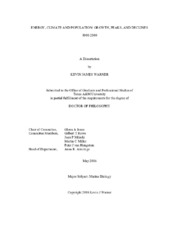| dc.contributor.advisor | Jones, Glenn A | |
| dc.creator | Warner, Kevin James | |
| dc.date.accessioned | 2020-02-27T19:54:38Z | |
| dc.date.available | 2020-02-27T19:54:38Z | |
| dc.date.created | 2016-05 | |
| dc.date.issued | 2016-04-29 | |
| dc.date.submitted | May 2016 | |
| dc.identifier.uri | https://hdl.handle.net/1969.1/187414 | |
| dc.description.abstract | This dissertation is derived from numerical models that quantitatively examine energy, climate, and population. Future energy production in each chapter is modelled using the single-cycle Hubbert technique. Population figures are taken from United Nations projections. Per capita energy consumption is projected in each chapter either using regression modelling, or as a set of goals unique to the study. Annual energy demand is a product of per capita energy consumption and population. Renewable energy demand is defined as the total energy demand minus the projected non-renewable energy production. Emissions from energy production are calculated from global-averages for each source.
The global-scale model of energy production and consumption suggests that peaking non-renewable energy will create renewable energy demand equal to 50% of global energy by 2054 and by 2028 in order to achieve climate goals. Similar modelling of regional-scale energy consumption goals highlights specific challenges for that energy transition, including population growth, development, and dependence on imported energy. A sensitivity analysis of the global model inputs uncovers that increasing current per capita energy consumption 3% negates the total global non-hydro renewable energy contribution. Additionally, doubling fossil fuel reserves results in 32% reduction in non-hydropower renewable energy demand by 2100.
After determining the changes required to achieve certain goals in Sub-Saharan Africa, a search for a sufficient historical analogue provided evidence that the changes necessary would be globally unprecedented. Next I determine potential emissions savings in the US, EU, and Russia given a sample climate plan. The results indicate that even with total decarbonisation by 2100, the rest of the world cannot industrialise via fossil fuels. Finally, evaluation of competing goals of development and carbon emissions in China and India reiterates that developing nations will have to choose between development and realistic climate goals.
The overall conclusions of this dissertation suggest that limiting global warming is not likely. A renewable energy infrastructure will need to be built regardless of environmental concerns. Reducing the gap in global economic and social inequality world via energy availability is a potential means of reducing the influence of population growth on each of the models in this dissertation. | en |
| dc.format.mimetype | application/pdf | |
| dc.language.iso | en | |
| dc.subject | energy modelling | en |
| dc.subject | climate change | en |
| dc.subject | population growth | en |
| dc.subject | development | en |
| dc.title | Energy, Climate and Population: Growth, Peaks, and Declines 1900-2100 | en |
| dc.type | Thesis | en |
| thesis.degree.department | Marine Biology | en |
| thesis.degree.discipline | Marine Biology | en |
| thesis.degree.grantor | Texas A&M University | en |
| thesis.degree.name | Doctor of Philosophy | en |
| thesis.degree.level | Doctoral | en |
| dc.contributor.committeeMember | Rowe, Gilbert T | |
| dc.contributor.committeeMember | Mileski, Joan P | |
| dc.contributor.committeeMember | Miller, Martin C | |
| dc.contributor.committeeMember | van Hengstum, Pete J | |
| dc.type.material | text | en |
| dc.date.updated | 2020-02-27T19:54:39Z | |
| local.etdauthor.orcid | 0000-0002-0155-852X | |


